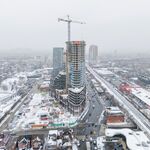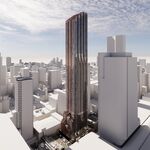Earlscourt_Lad
Active Member

I think that's a curved station....

Dentrobate, you can't build a station on a curve, and subway trains can't turn at 90 degree angles.
Just because you can connect dots on a map doesn't mean people want or need to travel between these points...you need a good reason to break off from a straight path in this city.
jn_12: It would be helpful to suggest a few places where you think more or less straight lines aren't good enough. Proposed/future extensions of all of the subway lines in Toronto aren't grid-straight (even Yonge will probably veer off to the east to hit the YRT terminal at the end). Eglinton's tunnel needs to be straight. Whatever gets built south of Bloor/Danforth, either a DRL or some kind of continuation of Transfer City Don Mills/Jane lines, will not be straight. The RT extension won't be straight.
We seem to pre-occupied with creating corridors, but one of the great things about subways is that there are no boundaries and they're capable of linking various neighbourhoods and places to one another without many limitations.
Doady,
An excellent map. One of the best I've seen. It's great to see people break free from the false dichotomy of "bus or subway". I feel like all the quibbles I have are minor. Though, one thing I don't get is why the Airport is served by a separate line, rather than being a continuation of either line 5 or 7?
I like your GTTA logo, too.
BTW, where did you get the base map from?
An idea I've had was to re-route the Barrie GO line though a tunnel to serve Dundas West, and still run the DRL through Dundas West. That could give us 2 subway lines, 4 GO lines, VIA service, and at least 4 surface routes at one place. Almost a second Union station. There's a good amount of redevelopable land around there too for office and condo developments. Rename it from "Dundas West" to "Davis Transportation Centre" or something similar.

Um, the current system's full of sharp right angle curviatures: St Clair, Broadview, Dufferin and Union just to name a few. What excuse is that not to build subways where they'd benefit the greatest number of riders (i.e. transit with local + long distance ridership demand)?
I was thinking of New York, which has a huge subway system but no airport connection, and New York is the only American city that has better transit than Toronto.




